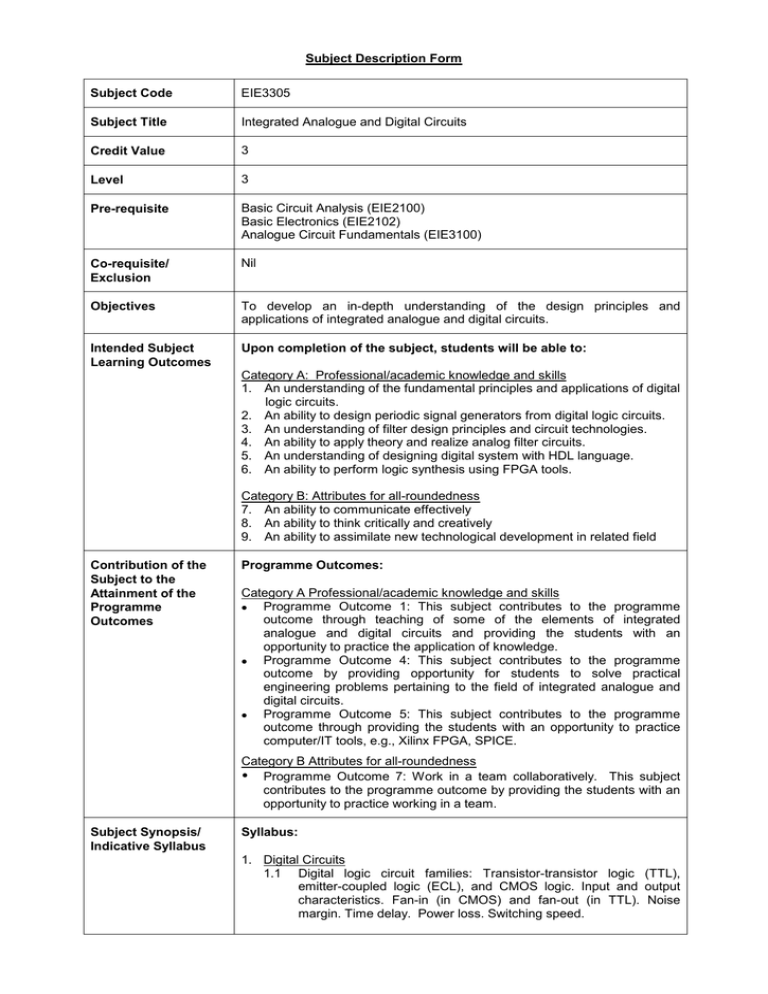EIE3305
advertisement

Subject Description Form Subject Code EIE3305 Subject Title Integrated Analogue and Digital Circuits Credit Value 3 Level 3 Pre-requisite Basic Circuit Analysis (EIE2100) Basic Electronics (EIE2102) Analogue Circuit Fundamentals (EIE3100) Co-requisite/ Exclusion Nil Objectives To develop an in-depth understanding of the design principles and applications of integrated analogue and digital circuits. Intended Subject Learning Outcomes Upon completion of the subject, students will be able to: Category A: Professional/academic knowledge and skills 1. An understanding of the fundamental principles and applications of digital logic circuits. 2. An ability to design periodic signal generators from digital logic circuits. 3. An understanding of filter design principles and circuit technologies. 4. An ability to apply theory and realize analog filter circuits. 5. An understanding of designing digital system with HDL language. 6. An ability to perform logic synthesis using FPGA tools. Category B: Attributes for all-roundedness 7. An ability to communicate effectively 8. An ability to think critically and creatively 9. An ability to assimilate new technological development in related field Contribution of the Subject to the Attainment of the Programme Outcomes Programme Outcomes: Category A Professional/academic knowledge and skills Programme Outcome 1: This subject contributes to the programme outcome through teaching of some of the elements of integrated analogue and digital circuits and providing the students with an opportunity to practice the application of knowledge. Programme Outcome 4: This subject contributes to the programme outcome by providing opportunity for students to solve practical engineering problems pertaining to the field of integrated analogue and digital circuits. Programme Outcome 5: This subject contributes to the programme outcome through providing the students with an opportunity to practice computer/IT tools, e.g., Xilinx FPGA, SPICE. Category B Attributes for all-roundedness Programme Outcome 7: Work in a team collaboratively. This subject contributes to the programme outcome by providing the students with an opportunity to practice working in a team. Subject Synopsis/ Indicative Syllabus Syllabus: 1. Digital Circuits 1.1 Digital logic circuit families: Transistor-transistor logic (TTL), emitter-coupled logic (ECL), and CMOS logic. Input and output characteristics. Fan-in (in CMOS) and fan-out (in TTL). Noise margin. Time delay. Power loss. Switching speed. 1.2 1.3 Multi-vibrators: Mono-stable, bi-stable and astable circuits. Saturating and non-saturating multi-vibrators. Schmitt trigger and 555 timer. Memory circuits: RAMs, ROMs and EPROMs. 2. Analog Filter Design 2.1 Basic filter principles. Filter approximations (e.g., Butterworth, Chebychev, elliptic, Cauer, etc.). Transfer functions for low-pass, band-pass, high-pass, and band-stop filters. Frequency responses (magnitude and phase). 2.2 Analogue filters: lossless passive realization and active RC realization. Standard first-order filters and biquads. 2.3 Discrete-time realizations. z-domain functions. Active switchedcapacitor realization. Standard first-order filters and biquads. 3. Introduction to HDL Styles Digital Design and Synthesis 3.1 Basic language structures: data types and modules. Structural and behavioural specifications: basic gates, user-defined primitives, modelling levels, synthesizable operations, continuous assignments. Procedural specifications: blocks, functions and tasks, blocking and non-blocking assignments, control and conditional constructs. 3.2 Basic design methodology: small module design, module validation, finite state machines. Managing large complexity leading to large designs. 3.3 Synthesis to FPGA: timing, area and power considerations. Laboratory Experiments: 1. Design of electronic circuits using Xilinx FPGA tools. 2. Simulation of filter design using SPICE. Teaching/ Learning Methodology Teaching and Learning Method Intended Subject Learning Outcome Remarks Lectures 1, 2, 3, 4, 5 fundamental principles and key concepts of the subject are delivered to students Tutorials 2, 4 students will be able to clarify concepts and to have a deeper understanding of the lecture material; problems examples discussed Laboratory sessions 4, 6, 7, 8, 9 and are application given and students in groups of 2-3 will conduct practical measurement and evaluate the performance of electronic circuits Alignment of Assessment and Intended Subject Learning Outcomes Specific Assessment Methods/Tasks % Weighting 1. Continuous Assessment Intended Subject Learning Outcomes to be Assessed (Please tick as appropriate) 1 2 3 4 5 6 7 8 9 40% • Short quizzes • Assignments • Tests • Laboratory sessions • Mini-project 2. Examination 60% Total 100% The continuous assessment consists of assignments, quizzes and two tests. Explanation of the appropriateness of the assessment methods in assessing the intended learning outcomes: Specific Assessment Methods/Tasks Remark Short quizzes mainly objective tests (e.g., multiple-choice questions, true-false, and matching items) conducted to measure the students’ ability to remember facts and figures as well as their comprehension of subject materials Assignments, tests and examination end-of chapter type problems used to evaluate students’ ability in applying concepts and skills learnt in the classroom; students need to think critically and creatively in order to come with an alternate solution for an existing problem Laboratory sessions, mini-project each group of students are required to produce a written report; accuracy and the presentation of the report will be assessed; oral examination based on the laboratory exercises will be conducted for each group member to evaluate his technical knowledge and communication skills Student Study Effort Expected Class contact (time-tabled): • Lecture 24 Hours • Tutorial/Laboratory/Practice Classes 18 hours Other student study effort: • Lecture: preview/review of notes; homework/assignment; preparation for 36 Hours test/quizzes/examination • Tutorial/Laboratory/Practice Classes: preview of materials, revision and/or reports writing Total student study effort: Reading List and References 27 Hours 105 Hours Textbooks: 1. R. Schaumann and M.E. Van Valkenburg, Design of Analog Filters, New York: Oxford University Press, 2001. 2. J.P. Hayes, Introduction to Digital Logic Design, Reading: AddisonWesley, 1993. Reference Books: 1. P.R. Gray, Paul J. Hurst, Stephen H. Lewis and Robert G. Meyer, Analysis and Design of Analog Integrated Circuits, New York: Wiley, 2001. 2. D. Van den Bout, The Practical Xilinx Designer Lab Book, Englewood Cliffs: Prentice-Hall, 1999. nd 3. S. Yalamanchili, VHDL – A Starter’s Guide, 2 edition, Prentice Hall International. 4. 4. D.R. Smith and P.D. Franzon, Verilog Styles for Synthesis of Digital Systems, Englewood Cliffs: Prentice-Hall, 2000. Last Updated Aug 2012 Prepared by Dr Martin Chow
